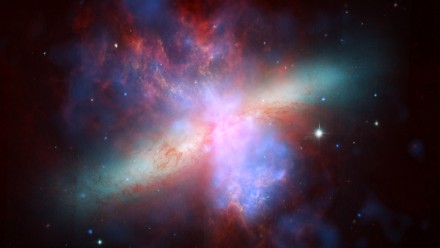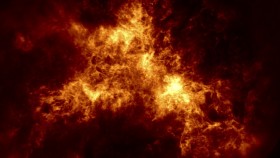Cosmic boiling pots
Galaxies in the Universe come in two different flavours. Some, like the Milky Way we live in, are full of gas and dust. They are disk-shaped, and actively form new stars. Others have very little gas, very little dust, and not a lot of star formation. Over the years, astronomers have gathered several pieces of evidence suggesting that galaxies evolve from the dusty, gas-rich category into the gas-poor category. Today, one of the questions debated by astronomers is, what is happening to the large quantities of gas in these galaxies as they evolve?
One of the mechanisms that can rapidly remove a lot of gas from a galaxy is known as a galactic outflow. "Imagine a stove with a pot of water on top," says Frédéric Vogt, a PhD student at The Australian National University (ANU) Research School of Astronomy & Astrophysics. "If the stove is not too hot, you will heat the water, but not much more. But if you crank up the heat, your water will start boiling away, and your pot will gradually empty itself. Well, some galaxies can do that very well too."
Stars, especially young and massive ones, can very efficiently heat their surroundings, both during their lives, and also when they die in massive explosions called supernovae. "Bring many of these stars together, and you get a very efficient cosmic stove," Frédéric explains. "You can create large bubbles of gas expanding away from the plane of the galaxy, just like the hot water-air mixture rising from your water pot. This is a very efficient way to take gas away from the galaxy."
Several questions about these galactic outflows remain to be answered. For example, how does a galaxy form enough young, hot stars to launch an outflow? "Galaxy interactions are a good way to do it," says Frédéric. "If two gas-rich galaxies pass close by each other, it can make the gas they contain fall towards the centre of each galaxy." When the gas reaches the centre, the pressure becomes high enough to form lots of new, massive, hot stars. These stars then drive a galactic outflow, which clears out much of the remaining gas.
In his PhD thesis research, Frédéric has been using the WiFeS integral-field spectrograph on the ANU 2.3m telescope at Siding Spring Observatory, NSW, to look at one of these galactic winds. "This object is an exciting target for two reasons. First, other astronomers have found an extended gaseous structure around this galaxy, but no-one really knew for sure what it was. Thanks to our observations, we now know that it is indeed a galactic outflow," Frédéric says. "The other interesting thing about this galaxy is that it has a nearby neighbour, a galaxy which hosts a galactic outflow of its own!"
These two galaxies, NGC 838 and NGC 839, are located in a 'compact group' - a special environment composed of just a few galaxies (in this case, seven), clustered together in a very small volume of space. These galaxies are subject to strong interactions with each other, which can have dramatic consequences, such as the formation of galactic outflows.
A galactic outflow is a complex phenomenon, which is still not perfectly understood. The structure of the outflow depends on the characterisitics of the host galaxy, and the past interactions the galaxy had with its neighbours. But, as Frédéric adds, "Understanding the exact interaction history of a galaxy is not always easy. So, it is difficult to figure out what matters most - the galaxy itself, or what happened to it in the past."
By identifying a second galactic wind in one compact group, the results of Frédéric's research may help astronomers better understand the formation of galactic outflows. Given the location of the two galaxies, it is likely that they have a similar interaction history. Any difference seen in the galactic outflows today must, therefore, be due to differences in the galaxies themselves. "And the differences are huge," says Frédéric. One wind is rather narrow, regular and symmetric. The other is very irregular, much more spread out, and asymmetric.
"These two galaxies are definitely great targets for future studies," Frédéric continues. "What is their star formation history? Are they very dusty? How much gas do they have available to form stars? That's what we need to look at next."
Frédéric's research has recenlty been published in The Astrophysical Journal, Volume 768, article id. 151.
Image: Multi-wavelength image of the galaxy M 82, the archetypal example of galactic outflow. The hot gas expanding away from the galaxy can be seen in purple (X-rays) and red (H-alpha). Credit: X-ray: NASA/CXC/JHU/D.Strickland; Optical: NASA/ESA/STScI/AURA/The Hubble Heritage Team; IR: NASA/JPL-Caltech/Univ. of AZ/C. Engelbracht. Original available here.















